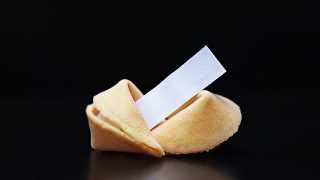

Back in the 19th century, a cookie very similar to the modern fortune cookie was made in Kyoto, Japan; and there is a Japanese temple tradition of random fortunes, called omikuji. The Japanese version of the cookie differs in several ways: they are a little bit larger; are made of darker dough; and their batter contains sesame and miso rather than vanilla and butter.
They contain a fortune; however, the small slip of paper is wedged into the bend of the cookie rather than placed inside the hollow portion. This cookie, called tsujiura senbei, is still sold in some regions of Japan.
The first modern-style fortune cookies reportedly were made by a San Francisco bakery and served by Makoto Hagiwara of Golden Gate Park's Japanese Tea Garden in San Francisco in the 1890s or early 1900s.
Several others also claim to have invented the cookie. David Jung, founder of the Hong Kong Noodle Company in Los Angeles, claimed that he did so in 1918. San Francisco's Court of Historical Review attempted to settle the dispute in 1983. During the proceedings, a fortune cookie was introduced as evidence with a message reading, "S.F. Judge who rules for L.A. Not Very Smart Cookie". A federal judge of the Court of Historical Review determined that the cookie originated with Hagiwara, and ruled in favor of San Francisco.
Seiichi Kito, the founder of Fugetsu-do of Little Tokyo in Los Angeles, also stakes a claim to its creation. He claims to have gotten the idea of putting a message in a cookie from fortune slips (Omikuji) which are sold at temples and shrines in Japan. He claimed to have sold his cookies to Chinese restaurants in both the Los Angeles and San Francisco areas, where they were greeted with much enthusiasm. Thus, Kito's main claim is that he is responsible for the cookie being so strongly associated with Chinese restaurants.
Up to around World War II, fortune cookies were known as "fortune tea cakes"—likely reflecting their origins in Japanese tea cakes.
Fortune cookies moved from being a confection dominated by Japanese-Americans to one dominated by Chinese-Americans sometime around World War II. One theory for this is because of the Japanese-American internment during World War II, which gave Chinese manufacturers an opportunity to step in.
Fortune cookies before the early 20th century were made by hand. However, the fortune cookie industry changed dramatically after the fortune cookie machine was invented by Shuck Yee from Oakland, California. The machine allowed for mass production of fortune cookies, which allowed the cookies to drop in price and become the novelty and courtesy dessert with which many Americans are familiar today.
Despite many rumors, fortune cookies were not invented in China. In fact, in 1989 fortune cookies were reportedly imported into Hong Kong as "genuine American fortune cookies". Wonton Food attempted to expand its fortune cookie business into China in 1992, but gave up because fortune cookies were considered "too American".
A recent visit to a favorite Chinese restaurant revealed the following fortune:
“For good health, eat more Chinese food.”
Hmm, maybe I should try a different Chinese restaurant?
Excepted and adapted from Wikipedia.com.


